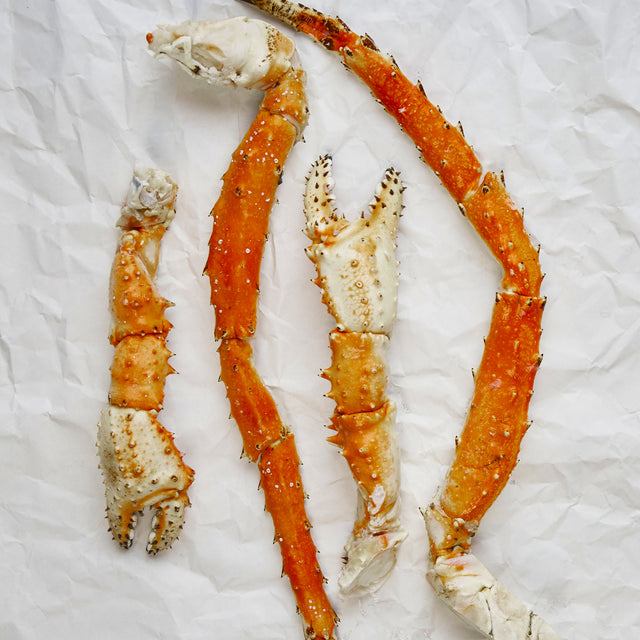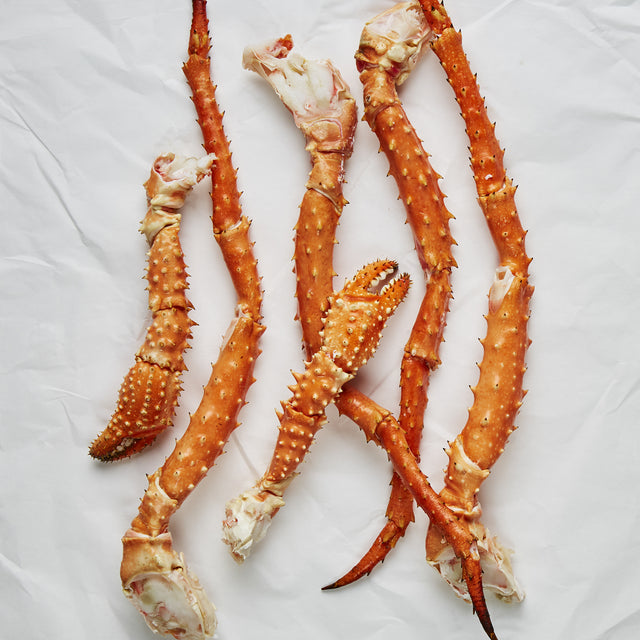Unmatched in size, quality and appearance, Alaska King Crab is one of the most sought-after of the Alaska crab species. Prized for its snow-white body and leg meat, it has a sweet, rich flavor and tender texture. The slight red membrane over the meat helps to lock in moisture. Averaging 6 to 10 pounds, Alaska King Crabs are available as individual legs and claws or as clusters. Both red and brown/golden king crab is widely available in the U.S. marketplace.

In the glory days of Alaska King Crab fishing, 15-pound red and blue king crabs were caught in the Kodiak and Pribilof island areas. However, due to significantly lower stocks since the early 1980s, these fisheries have been closed in an attempt generate new stocks.
Commercially, the Red Alaska King Crab is the most sought-after king crab, but the Blue and Golden Alaska King Crabs are also popular. There is a fourth type of Alaska King Crab called the Scarlet King Crab, which isn’t as well-known as the other three nor fished commercially as it’s smaller and harder to find.
All king crab that you buy online or in a grocery store has already been cooked by the commercial processor.
Did You Know? Alaska King Crab is a good source of quality protein and naturally low in fat and calories — the perfect addition to any table!
Timeline of King Crab Fishing
1940s – Post World War II: Japan begins commercial fishing activity for groundfish (i.e. king crab)
1958: U.S.S.R begins exploring king crab projects. Scientists introduce Russian Kamchatka into the Barents sea.
1959: State management begins of king crab fisheries inside and outside of Alaska waters.
1960: Adak fishery begins.
1961: Harvest of red king crab in Dutch Harbor begins.
1966: Dutch Harbor harvest peaks at 33 million pounds (14,969 metric tons).
1974: Foreign fisheries cease.
1977: Secretary of Commerce adopts and implements a Preliminary Fishery Management Plan for the foreign king and Tanner crab fisheries in the eastern Bering Sea, banning foreign fishing for king crab.
1977: Commercial fishery begins in Norton Sound.
1977-1980: Bristol Bay experiences all-time catch of 129.9 million pounds among 236 boats.
1981: Peak of king crab industry — 200 million pounds of crab is landed.
1983: King crab fishing stocks drop almost sixty-fold — over-fishing and environmental changes are identified as root causes. Warmer waters boosted the volumes of king crab predators (pollock and cod), causing the number of juvenile crabs to significantly decrease.
1989: Fishery Management Plan approved.
1993: Bristol Bay experiences stock declines again.
1994-1995: Fishing in Bristol Bay is closed.
1996: Harvest rate for Bristol Bay crabs reduced to 10% of males population.
1996-1997: Adak fishery closed.
1999: Pribilof Islands red king crab fishery closed.
2005: Crab Rationalization Program implemented, show the Deadliest Catch premieres on Discovery Channel.
2005-2006: 250 boats land 14 million pounds of red king crab in four days.
2008: The show the Deadliest catch airs for a fourth season and a fifth season is announced.
The Russian King Crab Mix-Up
In the late 50s, Russian scientists began a series of projects to introduce king crab into the Barents Sea. This successful initiative has now led to a giant influx of Russian king crab imported into the US market. Populations of king crab in the Barents Sea have risen ten times in the past ten years and is now estimated at 20 million crabs.
In 2006, approximately 90% of king crab in the world was Russian king crab, which accounted for more than 56 million pounds. Because of this supply, king crab prices were driven down, and those lower prices led to increased consumer demand, causing a surge in Russian imports. What’s most troubling for the Alaska King Crab industry is that the majority of Russian crab is imported illegally and marketed as Alaska King Crab due to its brand equity.
Now, Norwegian scientists are fearful that these Russian king crabs have migrated into Norwegian waters and will negatively impact cod and crab species.
Life Cycle of the Alaska King Crab
BABY KING CRABS
Once the Alaska King Crab reaches adulthood, the female crab will lay between 45,000 and 500,000 eggs each year. She clutches her eggs under her wide tail flap for approximately one year before hatching. Once the embryos begin to hatch, they will start to swim on their own in the form of larvae. King crab spends two to three months in larval stages, in which they are very vulnerable to being swept away by the current or tide. The ones that do survive feed off of the animal and plant plankton for the next several months.
It is during this time that the larvae begin to settle to the bottom of the water and the molt cycle begins. King crabs will molt approximately five times before taking on the appearance of a true king crab. This is the stage where they actually begin developing crab-like features and they can no longer swim. They are still very tiny during this stage of their life.
The skeleton of the Alaska King Crab is made up of mainly calcium and also serves as its shell. The crab must molt the shell before it will be able to grow and this process happens many times during the first few years of its life. As it matures, this process slows down. The females are required to molt before they can mate but the male will not have to. The males will often keep the same shell for a couple of years at a time.

JOURNEY OF YOUNG KING CRABS
Young king crabs tend to live in depths of 150 or below. From 2-4 years of age, Alaska King Crabs begin to form pods of thousands of crabs. Around year four (size of 2.5 in), crabs move from deeper waters during spring migration to join adults in shallower water to spawn.
After spawning ends, these crabs settle in waters between 90 and 200 feet for the remainder of the year. In particular, red king crabs like the softness of sand which is typically found in shallower waters. The Red and the Blue Alaska King Crabs prefer smaller depths while the Golden Alaska King Crab will settle in water at least three hundred feet deep.
Adult females must molt in order to spawn. After molting and fertilization, female king crabs will lay her eggs, which are typically hatched in the spring. And the life cycle begins again.
Did You Know? Some Alaska king crabs have been known to migrate over 100 miles to spawn.
FOOD SOURCE AND NATURAL PREDATORS
The Alaska King Crab feed off of clams, snails, sand dollars, worms, barnacles, sponges, algae and even smaller crabs to name a few of their natural food sources. However, what they eat is greatly affected by the size and type of crab and with how deep they live in the water.
The Alaska King Crab also has several natural predators that consider them a food source. Fish such as the halibut or Pacific cod are good examples of predators as well as sea otters, octopuses and other types of Crab.
Landside, fresh king crab is not only a draw to locals or visitors but also rodents. Dutch Harbor among other ports are fanatical about removing rats from the island. They constantly inspect incoming boats for rat or mouse droppings. This is evidenced by signs like the one below which hang throughout the small island.





